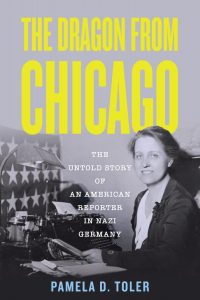Ann Stringer: The Widow on the War Front
Ann Stringer (1918-1990) was a reporter for the United Press before the beginning of World War II. She had reported alongside her husband, Bill Stringer, from Dallas, Columbus, and New York and as foreign correspondents in Latin America. By 1944, both of them were eager to be reassigned to Europe, where the real action was. They struck a deal with Reuters. Not surprisingly, Bill got his accreditation as a war correspondent first.* The plan was that Ann would follow as soon as her accreditation came through.
The day Ann was scheduled to leave for Europe, she learned that Bill had died in Normandy.
She was even more determined to get to the war front and cover the big stories. She sailed for England in late 1944 as an accredited war correspondent with the United Press. She filed her first story from London in January, 1945, then moved to the First Army press camp, where Bill had been assigned. According to Andy Rooney,** when Ann replaced Bill Stringer on the job “the rest of us in the First Army press camp didn’t know how to act toward her. Ann made it easy. She just picked up and did Bill s job, often with tears in her eyes.”
As is so often the case when a widow steps into her husband’s field boots, Ann exceeded expectations. And her colleagues at the United Press did not hesitation to admit it. According to Walter Cronkite, “She was tough. She knew what she wanted, and she knew how to get it. And she was one of the best reporters I have ever known. And, yes, she was beautiful.” Harrison Salisbury took his praise even further: “What I can tell you about her is that she was simply superb, the best man (I’ll say that even if it sounds chauvinistic) on the staff. Annie illuminated every one of her assignments. She was all reporter–not ‘girl reporter’—straight reporter. She was a two-fisted competitor.”
Stringer often ignored the Army’s restrictions on women in the front and was warned at least once that refusal to comply would lead to the loss of her accreditation. She learned to file her stories with vague datelines that wouldn’t trigger questions at army headquarters. When she couldn’t get official jeep transportation to the combat zone, she begged unofficial rides, including a lift over the bridge at Remagen from a general in a tank.
She is best known for sending the first dispatch reporting the link-up between the American and Soviet armies at Torgau, Germany, on the Elbe River, on April 26. She persuaded a friend in Army Intelligence to lend her and an INS photographer two small spotter planes and the pilots to fly them to Torgau. After an hour in Torgau, carrying her typewriter and a roll of film, she hitched a ride to Paris on a C-47 cargo plane and scooped her competitors/colleagues.***
Ann continued to report from Europe through the summer of 1945 and later covered the Nuremberg trials. In 1949, she left United Press, married German-born American photographer Hank Ries, and settled in Manhattan, where she continued to write for a variety of news media.
*Even before 1944, when the United States put regulations in place distinguishing between male and female correspondents, there were always limitations on women, even if they were “written in invisible ink” as photojournalist Margaret Bourke-White put it.
**Yes, that Andy Rooney. Even crotchety old icons were once bright-eyed young reporters. (Or maybe he was a crotchety young reporter. I don’t know for sure.)
***Other correspondents were always both.
***
Twelve days until the publication of The Dragon From Chicago! So. Dang. Excited.






